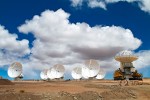Alma observatory captures stars being born, reports back on universe’s awkward teenage years

A baby book for our cosmos? That’d be a happy by-product of the massive insight star-gazing scientists are set to glean from Alma — the telescope responsible for ushering in a “new golden age of astronomy.” The Atacama large millimeter/submillimeter array (as it’s known in long form), located 3,000 meters above sea level on a Chilean plateau, goes beyond the voyeuristic powers of current optical telescopes, delivering detailed imagery of the dense gas clouds that birth baby stars. Why is this significant? Well, using the complex 20-antenna strong array (a total of 66 are planned), astronomers from North America, Europe and Japan will get a first-hand glimpse of the gaseous mix that was our universe a few hundred million years post-Big Bang . Consider the research a time-traveling peek back into the formative years of existence . Heady stuff, yes, but the array won’t have its multiple, celestial-focused eyes trained solely on star nurseries; scientists from around the globe already plan on getting an up close look at the Sagittarius A black hole . When these “Pyramids of the 21st Century” finish construction in 2013, we’ll be just one step closer to viewing the limits of our cosmic fishbowl. Alma observatory captures stars being born, reports back on universe’s awkward teenage years originally appeared on Engadget on Mon, 03 Oct 2011 19:09:00 EDT. Please see our terms for use of feeds . Permalink

Posted by
on October 3, 2011. Filed under
News,
Tech.
You can follow any responses to this entry through the
RSS 2.0.
You can skip to the end and leave a response. Pinging is currently not allowed.
Alma observatory captures stars being born, reports back on universe’s awkward teenage years

A baby book for our cosmos? That’d be a happy by-product of the massive insight star-gazing scientists are set to glean from Alma — the telescope responsible for ushering in a “new golden age of astronomy.” The Atacama large millimeter/submillimeter array (as it’s known in long form), located 3,000 meters above sea level on a Chilean plateau, goes beyond the voyeuristic powers of current optical telescopes, delivering detailed imagery of the dense gas clouds that birth baby stars. Why is this significant? Well, using the complex 20-antenna strong array (a total of 66 are planned), astronomers from North America, Europe and Japan will get a first-hand glimpse of the gaseous mix that was our universe a few hundred million years post-Big Bang . Consider the research a time-traveling peek back into the formative years of existence . Heady stuff, yes, but the array won’t have its multiple, celestial-focused eyes trained solely on star nurseries; scientists from around the globe already plan on getting an up close look at the Sagittarius A black hole . When these “Pyramids of the 21st Century” finish construction in 2013, we’ll be just one step closer to viewing the limits of our cosmic fishbowl. Alma observatory captures stars being born, reports back on universe’s awkward teenage years originally appeared on Engadget on Mon, 03 Oct 2011 19:09:00 EDT. Please see our terms for use of feeds . Permalink


Posted by
on October 3, 2011. Filed under
News,
Tech.
You can follow any responses to this entry through the
RSS 2.0.
You can skip to the end and leave a response. Pinging is currently not allowed.



